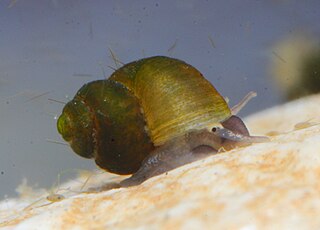Genus/ˈdʒiː.nəs/ is a taxonomic rank used in the biological classification of living and fossil organisms as well as viruses. In the hierarchy of biological classification, genus comes above species and below family. In binomial nomenclature, the genus name forms the first part of the binomial species name for each species within the genus.

Extinction is the termination of a kind of organism or of a group of children (taxon), usually a species. The moment of extinction is generally considered to be the death of the last individual of the species, although the capacity to breed and recover may have been lost before this point. Because a species' potential range may be very large, determining this moment is difficult, and is usually done retrospectively. This difficulty leads to phenomena such as Lazarus taxa, where a species presumed extinct abruptly "reappears" after a period of apparent absence.

The International Union for Conservation of Nature (IUCN) Red List of Threatened Species, founded in 1964, is the world's most comprehensive inventory of the global conservation status of biological species. It uses a set of precise criteria to evaluate the extinction risk of thousands of species and subspecies. These criteria are relevant to all species and all regions of the world. With its strong scientific base, the IUCN Red List is recognized as the most authoritative guide to the status of biological diversity. A series of Regional Red Lists are produced by countries or organizations, which assess the risk of extinction to species within a political management unit.

The conservation status of a group of organisms indicates whether the group still exists and how likely the group is to become extinct in the near future. Many factors are taken into account when assessing conservation status: not simply the number of individuals remaining, but the overall increase or decrease in the population over time, breeding success rates, and known threats. Various systems of conservation status exist and are in use at international, multi-country, national and local levels as well as for consumer use.

Belgrandiella is a genus of minute freshwater snails with a gill and an operculum, aquatic gastropod mollusks in the family Hydrobiidae.

Tandonia is a genus of air-breathing, keeled, land slugs. These are shell-less terrestrial gastropod mollusks in the family Milacidae.

Zospeum is a genus of air-breathing land snails, terrestrial pulmonate gastropod mollusks in the family Ellobiidae, the salt marsh snails.
In biology, a species is the basic unit of classification and a taxonomic rank of an organism, as well as a unit of biodiversity. A species is often defined as the largest group of organisms in which any two individuals of the appropriate sexes or mating types can produce fertile offspring, typically by sexual reproduction. Other ways of defining species include their karyotype, DNA sequence, morphology, behaviour or ecological niche. In addition, paleontologists use the concept of the chronospecies since fossil reproduction cannot be examined.
Tandonia serbica is a species of keeled air-breathing land slug, a terrestrial pulmonate gastropod mollusk in the family Milacidae.

The Krupa is a 2.5 km river in White Carniola, southeastern Slovenia. Its source is a karst spring in the village of Krupa below a rock wall. The bed has canyon characteristics in some places. At Gradac, the river joins the Lahinja from the left side. Its drop from the source to the outflow is only 6 metres (20 ft).
Dasumia is a genus of woodlouse hunting spiders that was first described by Tamerlan Thorell in 1875.
Dasumia kusceri is a spider species found in Greece.

Tandonia kusceri is a species of gastropods belonging to the family Milacidae.








